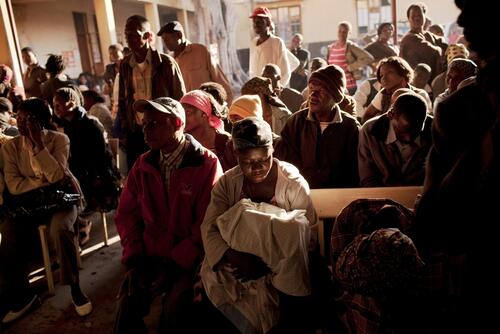Survival at risk for ten million waiting for AIDS treatment.
Background
Stavudine, or d4t, has side effects, which are burdensome, dangerous, and make it difficult to adhere to treatment; it is not part of the recommended therapy in Europe anymore. Yet it remains part of the most common first-line regimen in Africa for the simple reason that it is cheaper. The more robust tenofovir (TDF)-based first-line regimen, which is part of the new WHO guidelines, would allow patients to stay on their first regimen longer, delaying the need for more costly second-line regimens.
Earlier initiation of treatment at a CD4 cell threshold of 350 – as now recommended by WHO – results in better treatment outcomes and fewer incidents of TB and other opportunistic infections, while reducing the risk of transmitting HIV. For years, this has been the standard protocol in Europe. Yet few countries in the most affected regions of the world will be able to change their treatment protocols without a clear sign of increased international support.
AIDS leaders gathering in London on March 10 face the daunting challenge of implementing new World Health Organization (WHO) recommendations for earlier treatment with better AIDS drug cocktails at a time when donors are backing away from the promise of "universal access", warns Médecins Sans Frontières (MSF).
The WHO recently released new treatment recommendations for people living with HIV in developing countries which could help bridge the significant gap between the standard of care for people in northern and southern countries.
"In MSF programmes, we are striving to meet the higher standard of care which means starting patients on antiretroviral drugs earlier, which gives them a better chance of long-term survival," said Ariane Bauernfeind, programme manager at MSF in Brussels.
"I look forward to the day when I no longer have to see patients experiencing the painful and debilitating side effects of the drug stavudine (d4t). WHO recommends replacing stavudine with other drugs. However, we see ministries of health hesitating to make these changes because of a withdrawal of donor commitments."
Lesotho, although the poorest among the countries most affected by HIV, has already updated its national protocols in 2008, recognising the clinical and financial benefits of improved care. MSF is working with the Ministry of Health in rural areas to provide the optimal package of HIV/AIDS treatment, including an early start on a tenofovir-based regimen.
I look forward to the day when I no longer have to see patients experiencing the painful and debilitating side effects of the drug stavudine.Ariane Bauernfeind
Changing towards the improved WHO guidelines will cost more in the short term, but long term it is necessary for ensuring better survival and greater control of the epidemic.
"If the WHO's new recommendations are not implemented, the international community risks subsidising less expensive yet sub-standard care for developing countries," said Sharonann Lynch, MSF's HIV/AIDS policy advisor. "Avoiding this will depend on the willingness of donors to make new commitments. Although this is not easy in today's financial environment, donor countries cannot back away from supporting the promise of universal access to treatment made five years ago."
In 2005, the G8 committed to supporting AIDS treatment for everyone who needed it by 2010. But today the WHO estimates that only four of 14 million people needing AIDS treatment have access to it.
Many African countries facing crushing epidemics depend on external funding to sustain and scale up HIV treatment programmes. But the commitment of funders is waning. The United States President's Emergency Plan for AIDS Relief (PEPFAR) has kept funding flat over the past few years and scaled back financial commitment for treatment slots in some countries. Shifting donor priorities have also rendered uncertain the future support from the Global Fund to Fight HIV/AIDS, TB and Malaria. The Global Fund which has thus far paid for two thirds of the people who are currently receiving HIV/AIDS treatment needs to raise at least US$20 billion for the next three years of programmes.
Because of this funding retreat, some facilities are facing the stark reality of rationed treatment slots and need to turn away patients from clinics.
As an emergency medical humanitarian organisation, MSF has provided life-saving HIV/AIDS treatment for over 140,000 people in over 30 countries.




